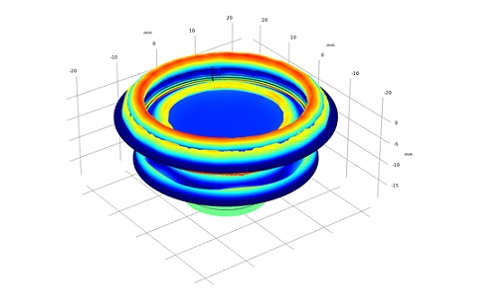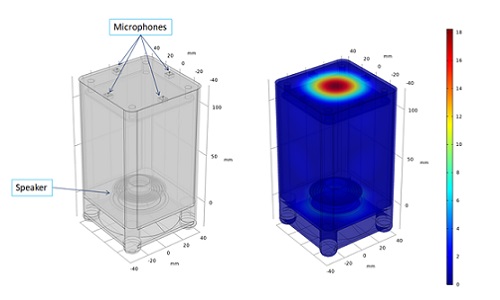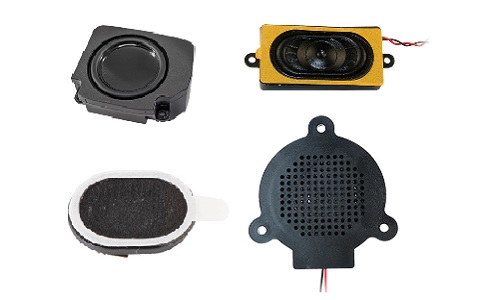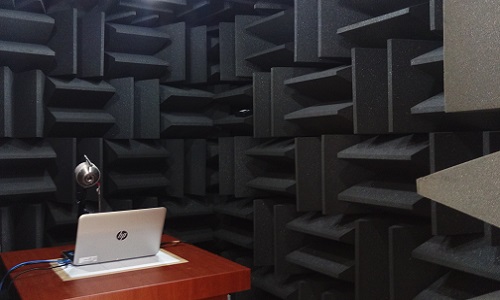-

Magnetic Circuit
Proper magnetic circuit design directly impacts sensitivities and cost when creating a successful speaker. Finite Element Analysis (FEA) tools can be used to find the best structure for arranging magnets and low-carbon steels, saving time and costs. This approach verifies all required parameters before making the real samples.
-

Driver study
The force factor (BL), the mass (weight) of moving parts, the cone's stiffness, and the suspension system's compliance all shape how a speaker sounds. An obvious requirement, such as high sensitivity, deep bass, or low distortion… will give the direction for driver design or the modifications to fine-tune. Driver designers first arrange the key parameters and later balance them with others to produce qualified speakers.
-

Polar plot
The smart speaker is a quickly growing business in the current market of consumer electronic products in recent years. Most ID designs have a cylinder with a down-firing speaker that tries to radiate and spread sounds evenly in a 360-degree spatial effect to satisfy single or multiple users who will move around in the home. The array microphones with a proper algorithm are the same concept for receiving sound from users. The geometry of the diffuser and the distance between a diffuser and the speaker's diaphragm will influence how the sounds spread out and radiate in the environment.
-

Vibration analysis
Recognizing the commands from the host's voice is important for a smart-home device, especially a smart speaker that plays music simultaneously. When talking to people on the Internet, the capability of echo cancellation allows smooth communications. Both functions rely on the high quality of the receiving path through the microphone. The quality will be significantly impacted if the vibrations of the device's walls and/or components are conducted from working speakers to microphones. We can build the simulation model to predict the situation and then give solutions to prevent it in the early design stage. Figure 1 shows a smart speaker that is designed with four array microphones.
-

Sound reflections
Some designs focus on sound performance in consumer electronics marketed products, while others concentrate on ID appearances and prices. A unique ID sometimes limits the position of the loudspeakers. How can we balance the ID appearances and acceptable sound performance? It's always a critique for designers. The FEA (Finite Element Analysis) tool can be used to predict and analyze the influences of sound performance when the ID is initially locked down, and the optimized position of a loudspeaker can be chosen. Here are three scenarios with different positions of loudspeakers inside a product. Figure 1 shows the loudspeakers' positioloudspeakers' product of the scenario 01.
-

Box Designs
Kingstate has influential mechanical engineers and an acoustic team. In many hard-to-develop acoustical products, designing speaker enclosures to meet customers' requirements is undoubtedly one of Kingstate's advantages. Speaker boxes can be designed in various shapes and simulated using COMSOL Multiphysics. We build simulation models to optimize our designs and reduce time and manufacturing costs.
-

Filling Material Application
Most acoustic designs for consumer electronics, such as laptops, tablets, A.I.O. systems… etc., usually have limitations of box geometry and an optimized position for speakers to place on the box. The problems here are the improper geometry of the box and the limited position to place the speaker, which will induce a standing wave inside the box, then causing a glitch or disturbance in frequency response at a specific frequency. That leads to an unwanted downgrade in sound quality. The issues can be predicted once the 3D drawing of the box and selected speaker with the defined position are defined.
-

Innovations
A compact and as thin as possible form factor is the mainstream of designing current laptops. That causes traditional round-shape speakers, which are limited by the diameter (i.e., length and width), not to be satisfied with state-of-the-art laptops. So, almost all loudspeaker designs for laptops have rectangular shapes to enlarge the vibrating area under a compact and limited space, and the longer, narrower, and thinner dimensions are the direction for future developments.

 RFQ
RFQ